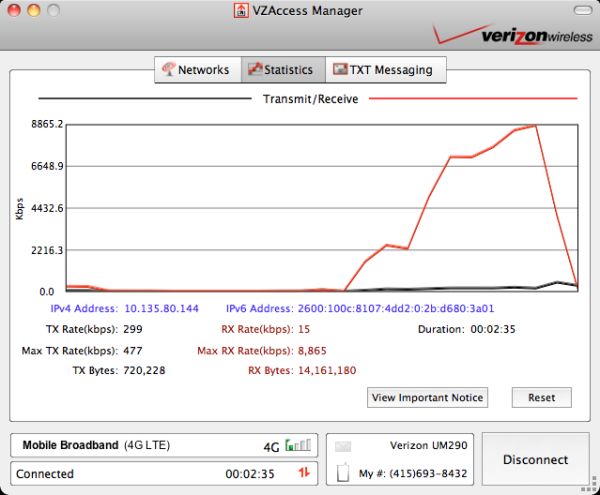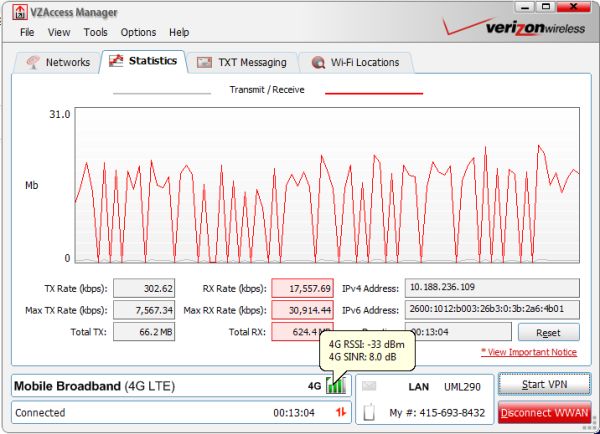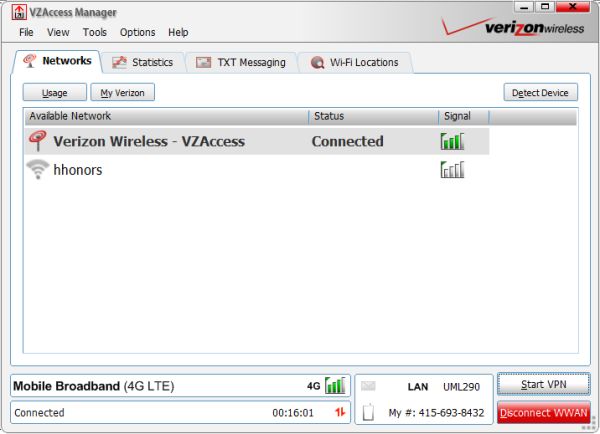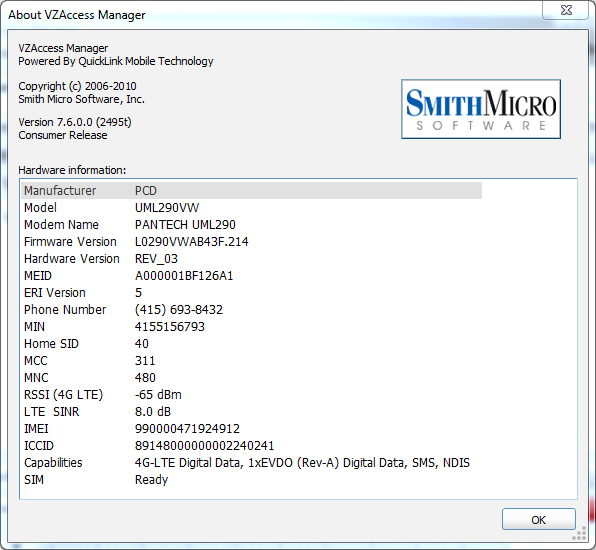Verizon 4G LTE: Two Datacards and a WiFi Hotspot Massively Reviewed
by Brian Klug on April 27, 2011 12:11 AM EST- Posted in
- Smartphones
- Samsung
- Verizon
- LTE
- 4G
- Pantech UML290
- USB551L
- Mobile
- MDM9600
Data Card Software: VZAccess Manager
The other part of the picture is software. Both modems use Verizon’s VZAccess Manager program on OS X and Windows. I guess that brings me to my primary complaint about both of these data cards—they don’t have internal storage partitions with the software stored on them.
In the past, data cards I’ve used seem to always have at very least a read only partition, sometimes even a microSD card drive letter, where drivers and management software were stored. The obvious reason for this was that you could then have a guaranteed way of getting online even if you didn’t have the driver CD with you. Without this, you can potentially be stuck in a maddening Catch-22 situation where you could conceivably get online, but only if you had the foresight to install drivers beforehand. I literally have a small pile of various modems for EVDO and UMTS that all have this simple feature.
So for some reason, all of Verizon’s launch 4G LTE modems lack an internal storage partition with the drivers, which is incredibly confusing. I sincerely hope newer modems have the feature, and that the reason this is lacking is purely due to the current architecture of these cards and not some legal preclusion.
I started using the UML290 before its first firmware update, and likewise before it had official OS X support. The UML290 needed a firmware flash from the Windows version of the VZAccess Manager; then I could download the OS X version of VZAccess Manager and use the UML290 without issue.
My initial testing results from the UML290 were taken on a Latitude XT running Windows 7, and later on an Inspiron 8500. However, I spent equal amounts of time just testing the two on a 2010 MacBook Pro and 2011 MacBook Pro.
 VZAccess Manager on OS X 10.6.7
VZAccess Manager on OS X 10.6.7
In Windows, VZAccess manager has a bit more configuration detail and offers different options than on OS X, but overall the organization and functionality is the same. There are tabs for both connectivity management, statistics, SMS/text messaging, and finally WiFi locations. At the bottom is a persistent bar displaying connectivity status, duration, activity, current cellular number (the data card still has a phone number for SMS), and signal strength. Hovering over the signal strength bars creates a bubble with more details about the current cell environment. When connected to 1x or EVDO, you get the current RSSI (Received Signal Strength Indication) for both 1x and EVDO. When connected to 4G LTE, you get both RSSI and SINR (Signal to Interference Noise Ratio).
I’m glad to see that SINR is being reported, since it’s very important on LTE to have a measure of how much noise there is in addition to inter-symbol-interference due to loss of orthogonality. This can come from reflections that exceed the cyclic prefix length, and more importantly from doppler shift, which causes loss of carrier orthogonality when the user equipment is moving quickly. Thankfully OFDM is engineered to work with this.
In LTE SINR is probably the most important quality metric; however, I feel like SINR is being reported incorrectly in the VZAccess Manager. Based on the definition of SINR and the data I collected, it seems that there’s either a missing negative sign, they report the inverse, or something else is wrong. Higher SINR is better and should result in better throughput.
VZAccess Manager by default pulls in your current usage statistics over SMS when you first connect. This is somewhat of a problem because it can force you to drop back to EVDO while the SMS is received. I disabled this in the client and never experienced any problems. On Windows, you can also send AT commands by hitting control-T, which is pretty much what you have to do to reconfigure proper APNs if you used the UML290 on OS X before the official firmware flash and update went out.
Inside the speeds tab is a graph of upstream and downstream throughput. There are fields for average and maximum over the sampling window down below, and running totals for the current data session. To the right are the local IPv4 address and IPv6 address. Back before an update, the graph for speeds used to have some strange sampling that would show a very odd throughput profile with periodic dips. This is fixed in the newer version and is much smoother, reflecting the actual throughput profile.
One thing that’s a bit frustrating is that inserting a new card requires you to click detect before the card can be connected. This can take a while sometimes unless you always use the same datacard. I’ve put together a full gallery with screenshots from the Windows and OS X versions of the access manager suite. There’s a majority of stuff which is virtually identical between the two versions.

Probably the most frustrating thing right now however is that there’s a disparity in what software versions the cards use on OS X. As of this writing, all the cards use 7.6.3 on Windows. However, on OS X, the USB551L uses 7.2.3 instead of the newer and more stable 7.2.5 that the older VL600 and UML290 datacards use. As a result, the newer USB551L (which is the only one with OS X support noted on the box) actually has worse OS X support than the two older cards that gained it from a firmware flash.
Further, I experienced a substantial number of kernel panics while using the USB551L on both a 2010 and 2011 MacBook Pro. Both computers had no kernel panics running 7.2.5 and the UML290. I experienced no instability or dropped connections with either card on Windows XP or 7. In that scenario, everything is perfectly stable. I have no doubt that all of these problems with the USB551L will be worked out with firmware updates and another software release that will bring everything up to version parity, but right now the situation is frustrating on OS X.
The Pantech UML290 as of this writing is going for $49.99 on a two year contract ordered online, or $249.99 without. The Novatel USB551L is selling for $99.99 on a two year contract ordered online, or $249.99 without. It’s odd to me that the UML290 is being discounted to $50 cheaper than the USB551L and VL600, especially considering that the UML290 in my opinion has vastly better build quality and current OS X support. It’s entirely possible however that it isn’t selling as well due to its rather large flip-out design.



















32 Comments
View All Comments
milan03 - Wednesday, April 27, 2011 - link
With my own testing and research, I've reached and exceeded 50mbps using USB tethered ThinderBolt here in NYC. Latency is also in the 50's and I'm extremely happy with the performance.Here are a few videos I've made:
http://www.youtube.com/watch?v=aVC10FMD8kg
http://www.youtube.com/watch?v=ccM_rbfVGDU
http://www.youtube.com/watch?v=YYVfZbmv34U
Brian Klug - Wednesday, April 27, 2011 - link
Wow, 50 Mbps is impressive! I've yet to see anywhere near that - highest was around 39 Mbps for me in Phoenix.-Brian
jigglywiggly - Wednesday, April 27, 2011 - link
WHY IS THIS FASTER THAN MY WIRED DOCSIS CONNECTIONAAAAAAAAAAAAAAAAAAAAAAAAAAAAAAAAAAAAAAAAAAAAAAAAAAAAAAAAAAAAAAAAAAAAAAAAAAAAAAAAAAAAAAAAAAAAAAAAAAAAAAAAAAAAAAAAAAAAAAAAaaaaa
ViRGE - Wednesday, April 27, 2011 - link
Don't worry. Once more than a handful of people are using LTE it won't be...Shared services are great until you have to start sharing them. And there's no sharing quite like sharing a limited RF spectrum.
milan03 - Wednesday, April 27, 2011 - link
Why should anyone be worried? You sound pissed...quiksilvr - Wednesday, April 27, 2011 - link
I'm pretty sure if you pay $50-$80 a month on it you will exceed it...unless on a barrel with Time Warner unzipping...Crazymech - Wednesday, April 27, 2011 - link
Man.. This is kinda.. Embarassing, really!I remember thinking "Pff.. Yea, those speeds? Riiiight" like a year, or one and a half year ago.
This is faster than my fiber connection! And it's wireless, and on a cellphone!..
What's next.. Amazing battery tech that's not "3 to 5 years" away?
Well done, LTE, I'm in awe.
Shadowmaster625 - Wednesday, April 27, 2011 - link
What's next? Cancer for everyone. Yay I cant wait.J_Tarasovic - Friday, May 13, 2011 - link
I am stoked about LTE as well. It really "grinds my gears" that both AT&T and T-Mobile are calling HSPA+ "4G" but I guess that is life, right?I am really waiting for MDM9600 based miniPCI-e WWAN cards. Any idea on this Brian?
Lord 666 - Wednesday, April 27, 2011 - link
The attention to detail is appreciated along with the scope of products tested.Completely agreed about the speed and performance numbers as I have all three; the SCH-LC11 was the best balance, followed by Thunderbolt, and then the Pantec 290 (fastest but limited to USB connection).